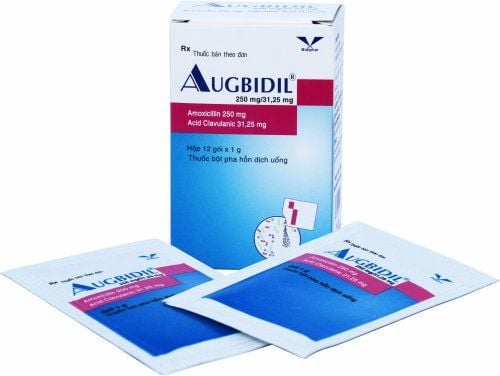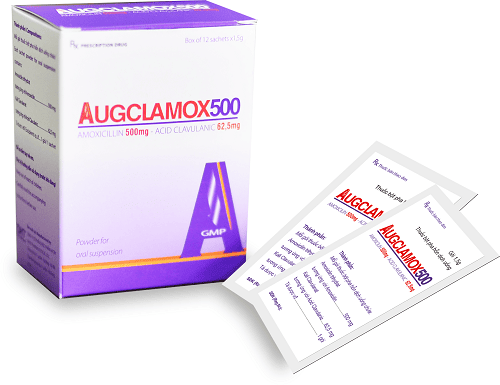This is an automatically translated article.
Cotrim Forte drug has the main active ingredient Sulfamethoxazol combined with Trimethoprim. This is an antibiotic with a broad spectrum of action, widely used in the treatment of various inflammatory diseases of the respiratory, digestive, urinary systems,...
1. What is Cotrim fort?
Cotrim Forte drug has the main active ingredient Sulfamethoxazol combined with Trimethoprim and other excipients in a sufficient amount. The drug belongs to the group of antibiotics that treat parasites, infections, viruses, and fungi. Cotrim Forte is available in the form of long-lasting tablets. Packaging is a box of 10 blisters, each blister contains 10 tablets
Cotrim Forte drug has a broad spectrum treatment effect on Gram (-), Gram (+) bacterial infections, especially for people infected with bacteria. gonorrhea, uncomplicated acute urinary tract infections, and Pneumocystis carinii pneumonia.
2. What disease does Cotrim fort treat?
Cotrim Forte drug is indicated for treatment in the following cases:
Treatment of urinary tract infections: Acute uncomplicated urinary tract infections; Chronic or recurrent urinary tract infections; Prostatitis. Treatment of respiratory tract infections: Treatment of acute attacks of chronic bronchitis. Treatment of gastrointestinal infections such as Shigella infection; traveler's diarrhea. Treatment of acute otitis media. Treatment of cholera when tetracycline is contraindicated or when Vibrio Cholerae infection is resistant to tetracycline. Treatment of pneumonia caused by Pneumocystis jiroyeci (formerly Pneumocystis carinii). Prophylactic treatment of diseases caused by Toxoplasma, treatment of diseases caused by Nocardia. Cotrim fort is contraindicated in the following cases:
People with known hypersensitivity or hypersensitivity to Sulfamethoxazole or trimethoprim or any of its ingredients. People with severe liver damage. Patients with severe renal impairment when renal function cannot be controlled or when clearance is less than 15ml/min. People with megaloblastic anemia due to folate deficiency. Pregnant and breastfeeding women. Children under the age of 2 months.
3. How to use and dose Cotrim fort
Cotrim Forte should be taken with food or drink to minimize the possibility of gastrointestinal upset. Dosage will depend on age and purpose of treatment:
For adults
Treatment of urinary tract infections: Acute uncomplicated urinary tract infections: 1 tablet every 12 hours for 10 days or Single dose of 2 tablets for a period of 3 to 7 days. Chronic or recurrent urinary tract infections: 1 tablet every 12 hours for 10 to 14 days. Prostatitis: 1 tablet every 12 hours for 3 to 6 months. Treatment of respiratory infections: Treatment of acute exacerbations of chronic bronchitis caused by susceptible strains such as Streptococcus pneumonia or Haemophilus influenzae: 1 tablet every 12 hours for 10 to 14 days. Pharyngitis caused by S.pyogenes: Co-trimoxazol should not be used. Treatment of gastrointestinal infections: Shigella infections caused by S. flexneri or S. sonnei: 1 tablet every 12 hours for 5 days. Diarrhea caused by E. coli: 1 tablet every 12 hours for 3 to 5 days. Treatment of acute otitis media: 1 tablet every 12 hours for 10 days. Cholera: 1 tablet and taken twice a day for 3 days in combination with fluid and electrolyte replacement. Prophylaxis of primary and secondary Pneumocystis carinii pneumonia in HIV-infected adults and adolescents: 1 tablet once daily for 3 consecutive days. Prophylaxis caused by Toxoplasma, treatment of diseases caused by Nocardia: 1 tablet/day for 14-21 days. For children: 8mg trimethoprim/kg and 40mg sulfamethoxazol/kg divided into 2 doses 12 hours apart.
In case of drug overdose, the patient may experience some symptoms such as: nausea, vomiting, diarrhea, dementia, facial swelling, confusion, headache, bone marrow failure and a slight increase in the index. serum aminotransferases (transaminases).
In case you forget a dose, you need to add the dose as soon as you remember. However, if the interval between the next dose is too short, skip the missed dose and resume the dosing schedule. Never use a double dose to make up for a missed dose.
4. Undesirable effects of the drug Cotrim fort
When using Cotrim fort, you may experience unwanted effects.
Common undesirable effects: Nausea, vomiting, anorexia and persistent diarrhea. Common hypersensitivity reactions: Fever, skin reactions including rash, pruritus, photosensitivity, exfoliative dermatitis and erythema. Serious Adverse Reactions: Potentially life-threatening, skin reactions including toxic epidermal necrolysis or Stevens-Johnson syndrome. Other undesirable effects include dermatitis, systemic lupus erythematosus, particularly exacerbation of existing diseases. Nephrotoxicity: Interstitial nephritis and tubular necrosis, low back pain, hematuria, hematuria, and dysuria may occur. Blood disorders: Agranulocytosis, thrombocytopenia, aplastic anemia, leukopenia, decreased prothrombin and eosinophilia. Liver enzyme disorders and cholestatic jaundice manifest as methemoglobin cyanosis, acute hemolytic anemia. Instructions on how to handle unwanted effects: When experiencing undesirable effects of the drug, it is necessary to stop using and proactively notify the treating doctor or go to the nearest medical facility for timely treatment.
5. Drug interactions of Cotrim fort
Some of the following drugs may interact with Cotrim fort:
Warfarin : Use of Cotrim fort may prolong blood clotting time in people taking warfarin because it inhibits the clearance of warfarin's metabolite. Phenytoin: Cotrim fort inhibits the metabolism of phenytoin. Methotrexate: Since sulfonamides can displace methotrexate in plasma protein binding, it increases the concentration of free methotrexate. Cyclosporin: Signs of nephrotoxicity but reversible in kidney transplants are taking Cotrim fort with cyclosporin. Digoxin: Increased serum digoxin levels may occur in people taking Cotrim fort, this interaction is more common in the elderly. Indomethacin: Increased plasma concentrations of sulfamethoxazole may occur with the use of Cotrim fort and Indomethacin. Amantadine: Delirium toxicity has been reported when Cotrim fort is co-administered with Amantadine.
6. Some notes when using Cotrim fort
Before using Cotrim fort you need to carefully read the instructions for use and refer to the information below.
Cotrim fort should be used with caution in people with kidney failure, people with potential for folate deficiency, such as the elderly, alcoholics, people taking anticonvulsants, malnourished people or people with syndromes malabsorption. People who are using Cotrim fort should pay attention to maintain adequate water intake to avoid urine crystallization and urinary stone formation. Ability to drive and use machines: Cotrim fort may cause dizziness, drowsiness, ringing in the ears, insomnia, and hallucinations. During treatment you should make sure you are unaffected before you drive or operate machinery. Pregnancy: Cotrim fort crosses the placenta and can affect the metabolism of folic acid, so it should be used during pregnancy only when the potential benefit outweighs the risk to the fetus. . Lactation: Cotrim fort is distributed into breast milk. Because sulfonamides can cause kernicterus in infants less than 2 months of age, a decision should be made whether to discontinue nursing or to discontinue Cotrim fort or to use an alternative drug, taking into account the importance of the use of the drug to the mother. .
Please dial HOTLINE for more information or register for an appointment HERE. Download MyVinmec app to make appointments faster and to manage your bookings easily.













